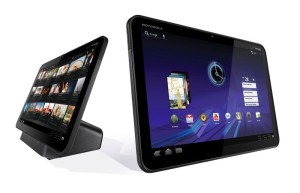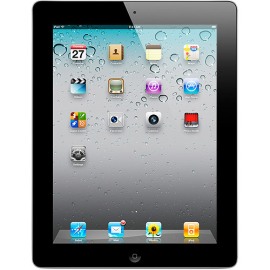The tablet war, as some has called it, is heating up as a slew of tablets are getting ready to hit the store shelves including the Blackberry’s Playbook, HP’s Slate, the iPad 2 and countless Android based tablets. With so many choices it can be quite confusing.
With so many choices it can be quite confusing.
 With so many choices it can be quite confusing.
With so many choices it can be quite confusing.The latest from Apple is industry darling and will dominate sales for some time to come. Towards the end of this year that very well could change as price sensitive consumers see many less expensive tablets flood the market and early adopters feel buyer’s remorse (what, you mean I can’t take a decent picture with this thing?). The other day I took the plunge and went into a Verizon store. Clearly Verizon is smitten with its new relationship with Apple and the iPad was quite prominent (same with Best Buy) but I went straight to the Android section where the 7 inch Galaxy Tab and 10 inch Motorola Xoom were on display. Within 20 minutes I was walking out of the store with the Xoom. The following is (to me) an objective look at the Xoom and comparing it to its main rival for now, the iPad2. Note, this is based on my, albeit limited, experience with the iPad as well as conversations with current iPad owners. Without making you wait until the end to read my verdict I’ll give it up here. They are both amazing pieces of technology and there really is no winner. Instead the solution that is best depends completely on how you plan to use it.
Hardware
The Xoom and iPad2 are fairly equally matched. However, the edge here does go to the Xoom (see chart below). This actually surprises me because I truly expected Apple to wow us with the iPad2 but instead the evolution was fairly mundane. Take for example the camera. The rear camera is .97 megapixels, about the quality of an early 90′s digital camera. The front camera is only .3 megapixels. Why did Apple hold back when the iPhone 4 has such an amazing camera? Tablets coming in the next month will make these specs look pathetic in reality and we can expect the iPad3 to improve quite a bit but that is 12 months from now. So, before you go stand in line, you may want to wait another month because there will be some pretty cool innovations coming (like 3D viewing and 3D HD recording along with more 4G compatible devices).
| Spec | iPad2 | Xoom |
| Screen | 9.7 inch 1024 x 768 | 10.1 inch 1280 x 800 |
| Camera | .3 MP front, .9 rear Yes, those are decimels | 2 MP front, 5 MP rear |
| Processor | dual core 1ghz | dual core 1ghz |
| Weight | 1.35 lbs | 1.5 lbs |
| Wireless | WiFi, 3g, Bluetooth | WiFi, 3g, 4g, Bluetooth |
| Connections | standard Apple connection to PC / Mac | USB, HDMI, Bluetooth transfer |
| Expansion | None | Up to 32 Gb SD card |
| Memory (storage) Memory (RAM) | 16, 32, 64 Gb 256 Mb | 32 Gb 1 Gb |
| Sound | Mono | Stereo |
| Thickness | .34 inches | .5 inch |
Winner: Android
The Environment
Apple’s iOS is considered the simplest of the OSes available. It is icon based and has been referred to as a simplistic, yet elegant launcher. You find the app you want and open it. The OS is really just a layer for the apps to reside. You don’t interact with it. The one area I have heard complained about is the notification system which, when compared to Android devices, is pretty bad.

Android is a different experience with widgets and customization based on how the user wants to interact with the device. Does that mean it is more complicated? I think that is a baseless argument. For example, my 5 year old son figured it out in the time it took me to turn around to see he had the device in hand. It was on, the lockscreen bypassed and he was reading Pulse, shortly followed by, “where is Angry Birds?” A little while later he was on YouTube watching volcano movies. To me, it has to be pretty easy for a 5 year old to pick it up and figure it out in less than a minute.
Multitasking is something Android has been able to play up since the beginning and the enhancements in Honeycomb (Android’s first tablet OS) are amazing. When you switch applications the previous remains on task. For example, I am writing this in Documents to Go and need to double check my facts so I switch to the browser. When I find the information I sometimes go back to Word to paste it and when I go back, the next website I clicked on before switching is loaded. That is a great timesaver. Also the browser’s multiple tabs can keep loading, etc. while I work in another tab. In iOS each tab has to refresh, slowing progress.
If you are at a PC / Mac the iTunes integration is fantastic but you have to be there. For as innovative as Apple is I would expect more cloud-based integration such as updates, etc. For media, apps like DoubleTwist have tried to replicate the iTunes experience on Android but significantly fall short.
Speaking of media, this is another place Apple wins. The media look and feel is close to flawless. Honeycomb improves the experience a lot but still has room for improvement. I think once Google launches its music and movie service this will change. One thing I do like about media on Android is Amazon. From within the app you can browse and purchase songs (50 cents cheaper than iTunes per song and up to $4 cheaper for albums) and they are right on your phone or tablet. No synching required. Same with books.
Winner: Tie – Beauty is in the eye of the beholder
Flash
This one I am going to give its own section, though it could be a part of the environment. Personally, I despise Flash and can’t wait for the world to move on to HTML 5. The problem…that move will be quite some time away. There are so many sites that require Flash it is incredible. Flash support in Android is huge because the entire web is available to you, not just the mobile versions of sites, for those that have them. Unfortunately, we are stuck with Flash for the foreseeable future so we might as well embrace it.
Winner: Android
Applications
Here the iOS wins hands down. There are 350k apps versus Android’s 150k but that is expected. This will change though as I believe there is a ceiling to how many apps any one ecosystem requires/can support. In addition, several surveys have shown app developers are more/equally interested in and investing in Android application development. On top of this, RIM just announced that the Blackberry Playbook will run Android apps. That only increases the available audience which will drive further developer interest. Still, iOS has a ton more apps available right now. I’m sure there are apps I would like to have on Android that are only on iOS but just don’t know what they might be…even though my friend James is always mentioning an app he has, each one of interest is available on Android.
Winner: iOS
As I started this post with, it depends on how you plan to use your device. Do you want to surf the web, play games and listen to music? Get the iPad2. If you, like me, want something that can almost replace a laptop without the annoyances of Windows or the premium price of a MacBook, the Xoom (and future tablets based on Android and likely WebOS and Blackberry) is the way to go. I have written this entirely on my tablet and for once, this past weekend, I didn’t have to turn on my laptop to work editing a whitepaper, emails and drafting press releases.
I would like to see more tablet specific apps but Honeycomb has only been available for 2 weeks. Luckily the phone apps scale really well. I’ve also found myself using the browser for apps like Facebook instead of the dedicated app. The full web interface is just better than what an app can provide, regardless of the platform.
I am sure some of you reading this fully expect me to say the Xoom/Android is the way to go but I am not. Yes I like to promote Android. Yes I can’t stand the Apple ecosystem in that you are forced to work through iTunes, there are no in app purchases, they price set vendors meaning a developer cannot offer a product or service at a discount elsewhere (many content owners such as Sony Music, Amazon and Real Networks are threatening to pull their content and anti-trust suits are in the works), and developers / content owners must fork over 30% of revenue to Apple (Google, by comparison, takes 10%). Even with all of that said, I want to be as objective as my mind will allow.
The Xoom has its issues. For one the software needs a little refinement. I stress a little. When I bought the T-Mobile G1, the first Android phone, it had issues and should not have been released when it was. After the first software update was pushed by Google and T-Mobile over the air, the phone greatly improved. Honeycomb is nothing like that. This is a beautiful piece of software and the responsiveness is amazing. When the first updates flow out for this, it will be truly amazing. Will a typical consumer notice the issues I’ve found? No, likely not. I’ve rooted my phone and run custom software on it so I am always looking out for bugs. That’s the techie in me…
The battle this year is also about the enterprise and based on what I’ve experienced so far, the Xoom is more capable. As I mentioned above, I have started to use the laptop my company provides much less. Kathy probably thinks I got this just as a new toy and she is partly right but I have used this a lot for work and as the application library grows, I know I will use it even more.
In the end, it is all about you and what you want technology to do for you and what you want to do with it. There are subtle differences there but they make a huge difference. The advancements we’ve seen in technology only means we get to enjoy the fruits of some damn smart engineer’s labor, so go out and enjoy it.
